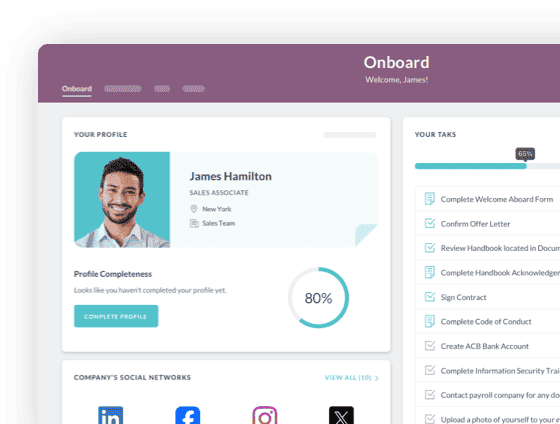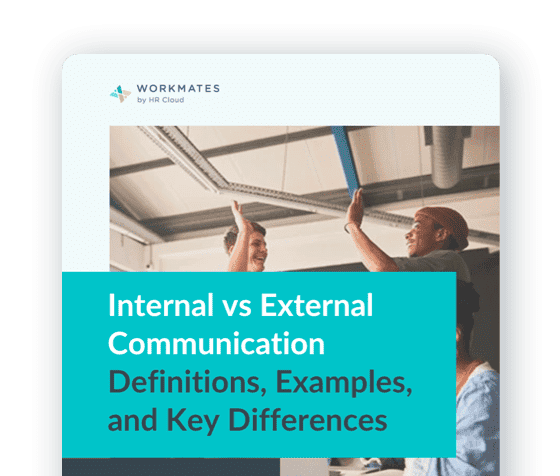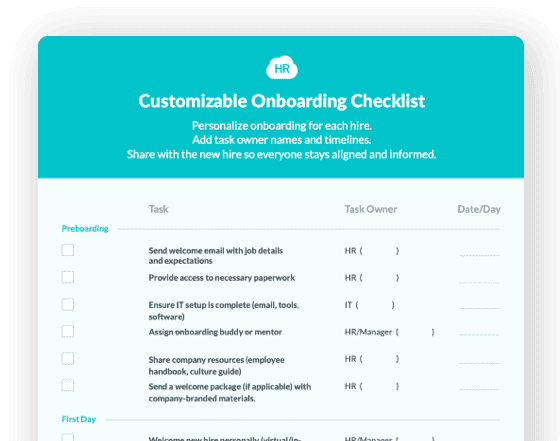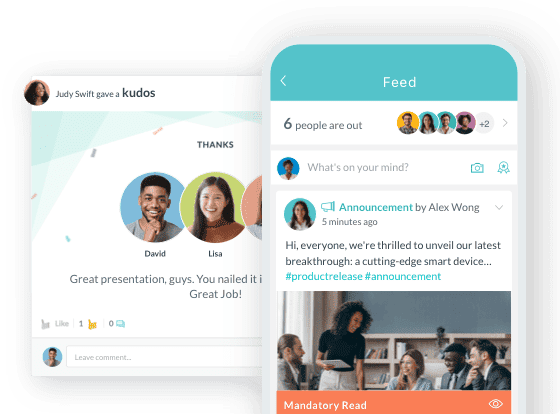

 Cut onboarding time
by 60%—here's the
Ultimate Checklist
that helped do it.
Cut onboarding time
by 60%—here's the
Ultimate Checklist
that helped do it.

The first few days at their new job can shape an employee’s perception of your company — for better or worse. A bad onboarding experience can have an adverse effect on morale, engagement, and retention. And yet, many organizations still treat onboarding as a checklist of forms and policies, rather than using structured onboarding checklists to create a consistent, strategic experience that sets the tone for performance and retention.
According to Gallup, only 12% of employees strongly agree their organization does a great job onboarding new team members. And, according to data collected by O.C. Tanner, 69% of employees say they will stay with a company for more than 3 years if they had a great onboarding experience.
That makes having a smooth employee onboarding a no brainer. Which need not be challenging as long as it answers all employee questions, gives them a clear understanding of how to integrate into the organization, and shares what to do if they ever have questions. And this is possible if you start equipped with the right employee onboarding checklists to guide the whole process.
Here we’ll share practical onboarding checklists you can start using immediately. Whether you’re onboarding remote hires, technical roles, or new managers, we’ve got you covered. Plus, you’ll find editable templates and best practices to help you create a repeatable process that scales.
Let’s get started.
How to Choose the Right Employee Onboarding Checklist
There’s no one-size-fits-all onboarding process. The right checklist depends on your company’s size, structure, and hiring goals. What works for a remote-first startup may not suit a large enterprise with multiple departments and locations.
To help you decide, here’s a quick guide to choosing the right checklist for your team:
|
Checklist Type |
Best For |
Key Features |
|
General New Hire |
All roles, any location |
Preboarding, Day 1 setup, 30-60-90-day milestones |
|
Remote Onboarding |
Distributed or hybrid teams |
Tech setup, virtual intros, async communication norms |
|
IT & Security |
Technical or compliance-heavy roles |
Device provisioning, access rights, security protocols |
|
Manager/Leadership |
Mid to senior hires |
Strategic alignment, people management, cross-functional visibility |
|
Compliance Checklist |
Regulated industries or enterprises |
NDAs, tax forms, training acknowledgments, audit trails |
What Makes a Great Employee Onboarding Checklist?
A checklist isn’t just a task list. It’s a blueprint for the new hire experience. The best onboarding checklists are structured, role-aware, and tied to business goals like engagement, productivity, and retention. Here’s what to include:
Preboarding Steps (Before Day 1)
The experience starts the moment a candidate says "yes."
-
Send welcome emails with clear next steps
-
Share company handbook, org chart, or culture deck
-
Collect completed forms (W-4, I-9, etc.)
-
Coordinate IT equipment delivery or desk setup
-
Add the new hire to calendars, Slack channels, and mailing lists

First-Day Essentials
Make it structured but not overwhelming.
-
Formal introductions with team and manager
-
Office or virtual tour
-
Review of job expectations and team structure
-
First lunch (virtual or in-person)
-
Overview of internal tools (email, HR portal, messaging apps)

Culture Immersion
Help them understand not just what to do, but how things get done.
-
Share your company’s mission, values, and origin story
-
Invite them to company-wide meetings
-
Assign a buddy or onboarding mentor
-
Include time for informal catch-ups with cross-functional teams

Compliance and Documentation
Don’t overlook the paperwork, especially for regulated industries such as healthcare, insurance and finance.
-
NDA, code of conduct, and safety policy acknowledgments
-
Required compliance training (e.g., security, anti-harassment)
-
Country-specific forms and documentation
-
Employee handbook receipt confirmation
-
Recordkeeping for audits and HRIS updates

Role-Specific Tools and Access
-
Enable productivity from Day 1.
-
Grant system logins and app permissions
-
Provide access to relevant files and project boards
-
Schedule tool-specific training (e.g., CRM, payroll software)
-
Align expectations with a 30/60/90-day success plan
-
Introduce key collaborators across departments

New Hire Onboarding Checklist
A well-organized onboarding process helps new employees feel welcome and productive from the start. Use this checklist as a framework you can tailor based on role, department, or location.
Preboarding (1–2 Weeks Before Start Date)
-
Send formal welcome email with start date, time, and point of contact
-
Share digital welcome kit (org chart, mission, team intros)
-
Collect signed offer letter and required documents (W-4, I-9, etc.)
-
Schedule IT provisioning: laptop, email setup, app access
-
Notify internal teams: IT, payroll, facilities, direct manager
Day 1 Checklist
-
Greet employee (in-person or virtually) and conduct orientation
-
Introduce to manager, buddy, and immediate team
-
Tour office or virtual workspace overview
-
Walk through role expectations and first-week goals
-
Provide login credentials, email setup, and access to collaboration tools
Week 1 Checklist
-
Assign onboarding buddy for informal support
-
Schedule check-in with HR to address questions or concerns
-
Set up recurring 1:1s with manager
-
Introduce to cross-functional teams they'll interact with
-
Share company policies, benefits overview, and time-off process
Day 30, 60, and 90 Milestones
-
Review progress toward 30/60/90-day goals
-
Conduct performance and feedback check-ins
-
Gather feedback on the onboarding experience
-
Confirm benefits enrollment and compliance training completion
-
Start aligning employees with long-term growth opportunities

Remote Employee Onboarding Checklist
Remote employees need more than just a laptop and login credentials. Without a structured plan, they can easily feel disconnected, underinformed, or overlooked. This checklist ensures your remote hires start strong and stay engaged, no matter where they work from.
Preboarding (1–2 Weeks Before Start Date)
-
Confirm tech shipment: laptop, monitor, accessories
-
Set up work email and permissions ahead of Day 1
-
Share a virtual welcome kit (company overview, culture guide, team bios)
-
Schedule a kickoff meeting with their manager
-
Send calendar invites for Day 1 sessions and welcome events
Day 1 Checklist
-
Welcome call with manager or HR
-
Team introduction via video or Slack
-
Walkthrough of essential tools (Zoom, Slack, HR platform, project tools)
-
Overview of remote work norms: availability, time zones, async guidelines
-
Share org chart and escalation paths
Week 1 Checklist
-
Assign a remote buddy or mentor
-
Schedule virtual meet-and-greets with key team members
-
Introduce communication cadences (daily check-ins, weekly standups)
-
Walk through onboarding checklist and self-serve HR resources
-
Encourage participation in social or interest-based Slack channels
Day 30, 60, and 90 Milestones
-
Manager-led performance reviews and coaching check-ins
-
Gather feedback on the remote onboarding experience
-
Confirm equipment setup and IT support satisfaction
-
Review long-term development goals and role clarity


IT and Security Onboarding Checklist
When onboarding technical or enterprise employees, IT setup isn’t just about access; it’s about protecting systems, ensuring compliance, and enabling productivity from Day 1. This checklist helps your IT team and hiring managers stay aligned.
Before Day 1
-
Provision hardware: laptop, monitor, phone (if required)
-
Set up company accounts: email, file storage, collaboration tools
-
Assign role-based software licenses (CRM, DevOps tools, admin portals)
-
Configure device management and endpoint protection
-
Activate MFA, SSO, and access control policies
-
Create user accounts in internal systems (HRIS, payroll, time-tracking)
First-Day Security Tasks
-
Conduct IT orientation and acceptable use policy review
-
Share documentation on secure login and password protocols
-
Verify successful access to key systems
-
Ensure backups are configured if applicable
-
Explain how to report security issues or request access changes
Compliance and Documentation
-
Collect signed security and compliance policy acknowledgments
-
Verify completion of mandatory security awareness training
-
Log system access and provisioning in audit-ready format
-
Confirm compliance with any relevant frameworks (e.g., SOC 2, HIPAA)
Ongoing IT Support
-
Assign IT point of contact or helpdesk onboarding ticket
-
Schedule a check-in to resolve setup or performance issues
-
Enable access to internal IT knowledge base or FAQs
-
Track access changes as roles evolve

Download an editable Google Doc for this IT Onboarding Checklist.
Manager and Leadership Onboarding Checklist
New managers and leaders need more than a company overview—they need context, influence maps, and clarity around strategic priorities. This checklist helps them ramp up quickly, build credibility, and lead with confidence.
Preboarding for Managers
-
Share leadership expectations, team structure, and current priorities
-
Provide a briefing document: team goals, org chart, key challenges
-
Schedule introductory meetings with direct reports and key peers
-
Assign an executive mentor or onboarding guide
-
Set up access to team performance data and reporting tools
First Week Essentials
-
Introduce to department heads, HRBP, and cross-functional partners
-
Conduct deep dives with each direct report
-
Review ongoing projects and inherited responsibilities
-
Walk through performance review process and goal-setting framework
-
Share cultural nuances, communication norms, and decision-making cadence
Strategic Alignment
-
Schedule onboarding sessions with senior leadership or founders
-
Review quarterly OKRs, department strategy, and budget process
-
Introduce leadership development resources or training modules
-
Align on the manager's 30/60/90-day plan with measurable outcomes
Support and Integration
-
Assign a leadership coach or peer mentor (if available)
-
Provide access to past performance and engagement data for their team
-
Discuss HR and legal protocols around hiring, performance, and feedback
-
Encourage check-ins with HR to navigate early team challenges
Download an editable Google Doc for this Manager and Leadership Onboarding Checklist.
Compliance and Documentation Checklist
For companies in regulated industries—or those scaling fast—compliance isn’t optional. It’s a critical part of onboarding. This checklist ensures you stay audit-ready while protecting both your employees and your organization.
Core Employment Documents
-
Offer letter and signed employment agreement
-
Tax forms (W-4, W-9, state-specific forms)
-
Direct deposit information and payroll setup
-
Acknowledgment of employee handbook and company policies
-
Emergency contact form
Confidentiality and Security
-
Signed NDA or confidentiality agreement
-
Acceptable use policy for technology and data
-
Acknowledgment of data privacy practices (e.g., GDPR, CCPA)
-
Training on phishing, password safety, and secure file sharing
-
Cybersecurity or information security training (if role requires it)
Workplace Policies and Training
-
Anti-harassment and workplace conduct policies
-
Equal opportunity employment acknowledgment
-
Health and safety training (especially for onsite roles)
-
Industry-specific certifications or disclosures
-
Accessibility and DEI policy acknowledgment
Recordkeeping and Audit Trail
-
Store all signed documents in the HRIS or secure digital folder
-
Timestamp onboarding task completions and policy acceptances
-
Document software access provisioning and deprovisioning
-
Maintain records for the legally required retention period

Download an editable Google Doc for this Compliance and Documentation Checklist.
Final Thoughts: A Checklist is Just the Start
A great onboarding experience doesn’t end with a checklist. Whether you're hiring one employee or fifty, checklists create structure, reduce errors, and free up your team to focus on what really matters: building relationships and driving performance.
Use these templates, tweak them to fit your culture, and revisit them often. Onboarding cannot be static since your team dynamic changes continuously.
And if you’re ready to move beyond manual processes, HR Cloud can help you streamline and scale your entire onboarding journey.
Schedule a personalized demo and see how to turn these checklists into automated workflows.
Author:
This article is written by Shweta in close association with HR Cloud. HR Cloud is a leading provider of proven HR solutions, including recruiting, onboarding, employee communications & engagement, and rewards & recognition. Our user-friendly software increases employee productivity, delivers time and cost savings, and minimizes compliance risk.
Keep Reading
Top 10 Healthcare HR Challenges That Right HR Platform Can Solve
Healthcare HR teams in 2025 face mounting pressure. A 2025 NSI survey found average
I-9 Compliance in Healthcare: Simplify E-Verify and Stay Audit-Ready (Free Checklist Inside)
An audit notice lands on your desk and your stomach drops. Missing I-9s, late E-Verify
Perfect Onboarding App for Nurses: Get New Caregivers Shift-Ready Faster
A meta analysis at the beginning of 2025 found nurse turnover rate to be 15-18% globally.
Like What You Hear?
We'd love to chat with you more about how HR Cloud® can support your business's HR needs. Book Your Free Demo

Build a Culture of Recognition. Boost Engagement. Guaranteed.
Workmates empowers employees to stay informed, connected, and appreciated—whether they’re on the front line, in the office, or remote. Recognition drives 12x higher engagement.Trusted by industry leaders in every sector




Cut Onboarding Costs by 60%.
Take the confusion and follow-ups out of onboarding with automated workflows, digital forms, and structured portals—so new hires ramp faster 3X quicker.Trusted by industry leaders in every sector




.png)
